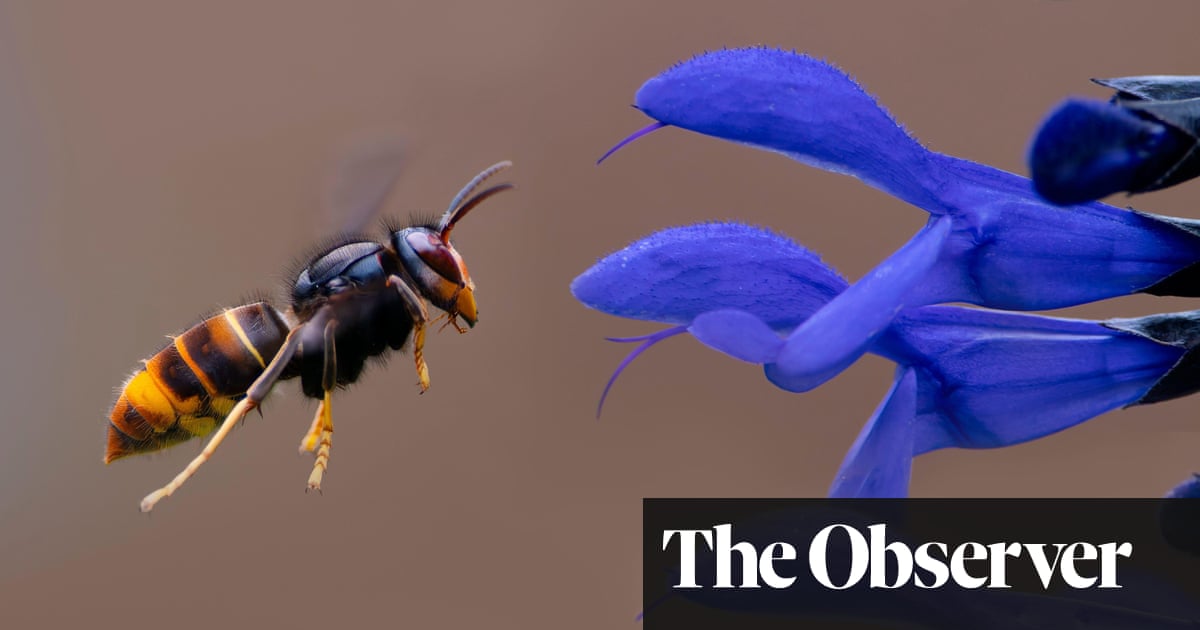‘Unprecedented’ sightings of Asian hornets raise fears for UK bees | Bees

They have bright yellow legs, are about 25mm (almost 1in) long, and a single colony, if left unchecked, can “butcher” 90,000 pollinating insects in just one season.
Since the first UK sighting in 2016 of Vespa velutina – the Asian or yellow-legged hornet – beekeepers and scientists have waged a vigorous campaign to minimise the damage this invasive species can do to Britain’s biodiversity and bee colonies.
Last year, a wet spring and washout summer appeared to have hindered the insect’s population growth as the number of nests spotted in the UK dropped from 72 in 2023 to 24 in 2024. But it was also the first year that the National Bee Unit received confirmation, via DNA, that the hornets had successfully bred and over-wintered in the UK.
Now experts fear the dry, sunny start to spring this year and the rapid spread of the species in Europe will lead to a surge in this year’s numbers.
“Unprecedented” early sightings of Asian hornets have been recorded in Jersey, leading experts to suspect that record numbers could try to establish nests in the UK this year.
“The first queens were more than two weeks early this year,” said John De Carteret, a founding member of the Jersey Asian Hornet Group, which has about 550 traps in place this year. “We’re obviously concerned.”
There were 262 queen Asian hornets recorded on Jersey by 11 April, a year-on-year increase of 1,090%.
“When we reach 266 queens, we will equal the total from 2024 – and that figure wasn’t reached until 25 June,” said De Carteret.
Ian Campbell, of the British Beekeepers Association, said: “There’s a strong risk of this year’s numbers being at least as high as in 2023 and the potential to be even higher. It would be a surprise if numbers were not above the 2024 level.”
The species is carnivorous, and a typical nest of between 2,000 and 3,000 Asian hornets can devour more than 11kg (about 24lb) of insects a season, according to Campbell – about the weight of 90,000 bees.
The public is being urged to “be vigilant everywhere” and learn how to identify and report Asian hornets, which have yellow legs and a distinctive orange band on the fourth segment of their abdomens – alongside entirely black velvety thoraxes, which distinguish them from the native European hornet.
Like bees, their stings can cause painful and potentially deadly allergic reactions. Any “sightings of concern” should be reported to the government’s National Bee Unit via the Asian Hornet Watch app or online, using the UK Centre for Ecology and Hydrology (UKCEH) reporting tool.
“Yellow-legged hornets cause significant damage to native pollinators, including our much-loved honeybees,” said Kate Wilson, head of the National Bee Unit. “Thanks to increasing reports to the app and online, it is not unexpected that sightings may occur earlier in the year. We encourage the public to remain vigilant and continue to report any potential sightings to us.”
Such sightings can help people working to combat the spread of Asian hornets to understand the national picture. “I collected one from a lady in her 80s after she captured it in a yogurt tub, while the youngest person who reported one was eight,” De Carteret said.
Ecology professor Helen Roy of UKCEH and Exeter University said the hornets pose “a major threat” to wildlife and biodiversity: “There isn’t a natural enemy that we’re aware of that could control the Asian hornet.”
It is thought that successive generations of the offspring of a single mated queen, which was accidentally introduced to France in a container of Chinese crockery in 2004, have now reached 15 European countries, including the UK. “In some countries like Spain and Belgium, we’ve seen numbers increase from a handful of nests to 10,000 nests in four years,” said Campbell.
France is believed to have more than a half a million nests, which researchers believe could be costing the French economy an estimated €30.8m a year in lost bee colonies and honey revenue, while the invaders have reduced honey production by 35% in Portugal and 50% in Liguria, Italy, in recent years.
In March, the first large-scale study of the Asian hornet’s diet, run by researchers at Exeter University, found 1,400 different species in their guts. Of the top 50 invertebrate prey species identified, 43 were known to visit flowers. These included Europe’s three main crop pollinators: the European honeybee, the buff-tailed bumblebee and the red-tailed bumblebee.
De Carteret, a retired police forensic officer, said hornets will typically “butcher” this prey by biting off their heads, wings, legs and abdomens so that their thoraxes – a source of protein – can be fed to the queen’s larvae.
So far this year, there have been only two confirmed sightings of yellow-legged hornets in the UK, but “now is the time for people to be on the lookout”, Roy said.
If the government had not destroyed the nests the public has been reporting since 2016, modelling by Exeter University suggests that the hornets would already be established in large areas of England and Wales, and entering Scotland.
Campbell said it was important to try to take photos of suspected Asian hornets and their nests: last year, from more than 29,000 reports, only about 70 were deemed accurate enough to be confirmed sightings. “To be successful with eradication, the National Bee Unit needs to get every single nest,” he said.
New hornet queens are constantly buzzing into the UK from Europe to replace those that have been eradicated. “The Asian hornet can arrive in a lot of different ways. It can come in on fresh produce or within someone’s car, across any Channel crossing,” Roy said. “Everyone needs to be vigilant, everywhere.”
Source link






